
The work from home trend was already in full swing when the COVID-19 pandemic hit and made remote work the standard for most companies. Since then, millions of companies have had empty offices with employees all working from their homes.
It’s not a situation that is likely to entirely go away, even once the pandemic-driven need subsides. It’s clearly been effective for many companies, and for some, it’s also an opportunity to reduce physical footprint and save on real estate and other related costs. Already, many companies have announced permanent changes to their WFH policies, and many more have extended them well into 2021. According to Gartner, 74% of companies will permanently shift some of their workforces to remote scenarios once the pandemic-driven need for teleworking subsides.
That said, it’s not quite as simple as just sending people home. They need the technology to work effectively from home. That includes not only the hardware and access to corporate networks, as well as the applications and permissions to communicate effectively, but also secure, reliable connectivity. It also includes striking some balance between business and personal lives in an environment that has traditionally been reserved for only the private side.
The laptops, video conferencing and unified communications applications, and corporate network access are fairly easy to accommodate, especially with the availability of free or low-cost cloud-based communications solutions.
What isn’t quite as easy is the security piece. When you have people working from home, the risk to corporate networks increases significantly. Think about all the smartphones, tablets, laptops, TVs, smart speakers, doorbells, and other connected home devices that are attached to home WiFi networks today. The average U.S. home already has a dozen connected devices, a figure expected to reach 20 by 2025.
Not all of them are fully secure, however, and even those that have adequate security features don’t always receive timely updates to patch flaws or address new threats. Each device is a potential entry point into home WiFi networks, also putting corporate networks at risk when employees connect from home.
The simple matter is corporate IT teams don’t have access to or insight into home WiFi networks to manage security effectively, or to provide support to employees. In the office, they have control over the network infrastructure for troubleshooting, monitoring, and management.
Minim is changing that for the new WFH era. The New Hampshire-based company has built an AI-driven managed WiFi and security platform with a set of “Work-Life WiFi” features to make it easy for businesses to support their remote workers. The solution not only helps bring reliable WiFi connectivity to employees’ homes, but includes features to allow IT teams to manage security, without compromising employee privacy. Until now, businesses have not had the ability to bridge the gap between enterprise and consumer platforms. Now, by providing Minim-enabled WiFi systems to employees, businesses can give IT teams the visibility to configure, optimize, and secure home environments for remote work, without compromising personal privacy.
“We’re breaking down the barriers between consumer and business networking because that’s our new reality,” said Nicole Hayward, co-founder and CMO/CPO of Minim. “As businesses ask employees to take the office network home, IT assistance is needed to safeguard corporate data and continuity. Yet, employees don’t want cumbersome equipment or Big Brother in their personal spaces.”
How does it work? For the user, it’s quite simple – no more difficult than setting up a modern home WiFi system. Many of them use app-based instructions to guide users through the setup process – the same strategy Minim has adopted.
Using the software, users are able to create two separate SSIDs at home, labeled “home” and “work,” for instance. This allows users to connect work devices to corporate resources on the “work” network, while personal devices connect to the “home” network. This eliminates potential risk to corporate networks from connected home and other consumer devices that may not be adequately secured.
The corporate IT access and features are delivered as a cloud-based managed service. IT teams will have access to the “work” network to manage devices, security, and access, but they will not be able to see the “home” network or any of the personal devices. IT teams access security features in the cloud, including access controls, device isolation, zero-day protection, network traffic analytics, and more.
Users also have a variety of management features to help them effectively secure and control their “home” networks and usage, including device fingerprinting, parental controls, and more.
“Until now, employees have had the option of consumer-grade devices that allow them to have insight into their home networks, but provide no insight to corporate IT for security and support,” said Hayward. “We are covering both personal and enterprise use cases.”
In addition to being able to create separate SSIDs, Minim’s platform includes several other features to support dual-need WiFi for today’s businesses.
- Private SSID – makes the home network invisible to corporate IT
- Device isolation – disable communication between devices (e.g., smartphones and smart TVs) to reduce risk
- Read only SSID – prevent employees from making changes to “work” network settings
- Hidden/no broadcast SSID – hide dedicated IT networks from the mobile app or prevent the IT network from being broadcast
- AI-driven security to protect against viruses, router attacks, ransomware, network intrusions, spyware, and more
- Device profiles for scheduling internet access or prioritizing bandwidth
There’s also an additional neat feature for the millions of smart speaker users out there. When plugged in, the speakers – Google Home, Amazon Alexa, etc. – perpetually listen to conversations in the home. Minim includes a setting to pause those listening devices during the workday or during specific conversations, to prevent those speakers from hearing any private or sensitive conversations.
“Now, with Minim, businesses can protect and support their distributed networks while providing a new-age employee perk—powerful, safe, and private home WiFi,” added Hayward.
Indeed, it’s really the best of both worlds. Businesses get the network visibility and access they need to secure  remote workforces, and employees get reliable, secure WiFi for their home devices. As Hayward explained, it’s really about minimizing WiFi headaches for both business and personal users.
remote workforces, and employees get reliable, secure WiFi for their home devices. As Hayward explained, it’s really about minimizing WiFi headaches for both business and personal users.
“We think of it as harmonizing the smart home and making everything work well together,” said Hayward.
In fact the name, Minim, comes from the musical term for a half note.
As a software platform, Minim is hardware agnostic is has already partnered with several WiFi vendors that have embedded its hardware in their devices, including Motorola’s MH7022 system, an expandable mesh WiFi system that can provide whole-home coverage in any residence.
Minim recently announced a distribution partnership with Telarus, which will help drive its technology into the remote work market. Don’t miss your chance to meet with Telarus to learn more about how its partnership with Minim is helping meet business needs in this new work from home world. Telarus will be exhibiting in booth #564 at ITEXPO, part of the #TechSuperShow at the brand new Miami Beach Convention Center, June 22-25, 2021. Minim is also a great opportunity for MSPs to provide additional value to their customers who are dealing with having to support remote workforces.
Edited by
Erik Linask





